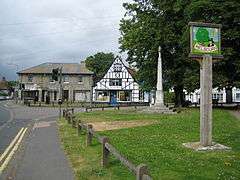Melbourn
Melbourn (/ˈmɛlbɔːrn/) is a large village in the far south-west of Cambridgeshire, England. It is located next to the A10 just north of Royston. Melbourn has over 4,400 inhabitants. Melbourn is located in the South Cambridgeshire District, but is served by the Royston, Hertfordshire post town.
| Melbourn | |
|---|---|
| Village | |
 | |
 Melbourn Location within Cambridgeshire | |
| Population | 4,414 [1] 4,689 (2011)[2] |
| OS grid reference | TL385445 |
| District | |
| Shire county | |
| Region | |
| Country | England |
| Sovereign state | United Kingdom |
| Post town | ROYSTON |
| Postcode district | SG8 |
| Dialling code | 01763 |
| Police | Cambridgeshire |
| Fire | Cambridgeshire |
| Ambulance | East of England |
The Prime Meridian passes to the west of Melbourn.
History
The parish has a long history of occupation, stemming from the presence of springs at Melbourn Bury and the several ancient trackways that cross the parish; the Icknield Way runs to the south of the parish and Ashwell Street and the Roman Cambridge-Royston road are also believed to follow prehistoric trackways. Pottery and burial finds show evidence of Bronze Age residents, and a Roman settlement has been found at the north-east edge of the village. Excavations in the 1950s discovered 28 graves from a 7th-century Christian burial site close to Ashwell Street.[3]
Melbourn appears in five entries in Domesday Book.[4]
The name "Melbourn" comes from Meldeburn, the "stream of a man named Melde".[5]
Church
The finding of a Saxon cemetery shows that Christianity has been present in Melbourn since the 7th century. The village also probably had an 11th-century chapel but the first record of a church is from 1152. The present church, dedicated to All Saints, is grade II* listed.[6] R.R. Rowe conducted a major restoration in 1882 but the church includes sections of the 13th-century building, including the chancel arch and sections of the tower.[6] The font is 11th century.[3]
Village life
It has a primary school and a state secondary school, Melbourn Village College. There is also a well-known science park. There is a butcher's, a co-op food shop, five hairdressers, a barber shop, two estate agents, two pubs, a newsagent, a sub-post office, two garages and three churches (Anglican, Baptist and URC). Melbourn has the well-known restaurant Sheene Mill, formerly owned by the television chef Stephen Saunders.
The village is served by Meldreth railway station, which opened in 1851 in the neighbouring village, Meldreth.[3]
Pubs
Melbourn was much visited by travellers by the 17th century and is listed as having an inn in 1622. By the late 18th century the village supported three: the Dog, of unknown history, the Red Lion, that closed towards the end of the 19th century, and the Hoops, that closed in the early 20th century. In 1865 the village had 11 inns and pubs, including the Black Horse, the Star, the White Lion, the Anchor, the Carriers Arms and the Red Cow. The Rose Inn and the Coach and Horses opened in around 1850.[3]
The oldest of the two present public houses is the Dolphin, which is listed from 1818.[3] The other pub in the village is the Black Horse.[7]
References
- 2001 Census Archived 2011-06-09 at the Wayback Machine
- "Civil Parish population 2011". Neighbourhood Statistics. Office for National Statistics. Retrieved 20 July 2016.
- A. P. M. Wright (1982). A History of the County of Cambridge and the Isle of Ely: Volume 8. Victoria County History. pp. 67–82.
- http://opendomesday.org/place/TL3844/melbourn/
- Walter Skeat (1901). The Placenames of Cambridgeshire.
- Historic England. "Parish Church of All Saints (1127546)". National Heritage List for England. Retrieved 3 May 2014.
- "The Black Horse, Melbourn". What Pub. Camra. Retrieved 16 November 2019.
External links
| Wikimedia Commons has media related to Melbourn. |